Return to Croatia - Dalmatia, day 1
POSTED ON 24/08/2010What better excuse for island hopping I thought last year than an in-depth look at plavac mali. In the absence of that opportunity, I did the tasting instead. This year, I managed to combine the two with a short visit to Croatia’s Dalmatian coast. I started off on the mainland and the island of Korćula (day 1), headed for the Pelješac peninsula (day 2) and finished off on the beautiful island of Hvar. So beautiful in fact that I stayed on for a few more days relaxation, an experience I thoroughly recommend.
For reasons that will become clear if you check out what happened – and didn’t happen – on my way to Croatia coast last month (http://www.anthonyrosewine.com/journal/2010/8/funny-thong-happened), I ended up arriving at Mali Ston on the coast way after 10 pm. By this time, Ernest Tolj and a small group of less than bright-eyed winemakers who’d been waiting for Saša Špiranec, Croatia’s leading wine writer, and me, had just about finished their dinner at the pretty seafront fish restaurant, Kapetanova Kuca.
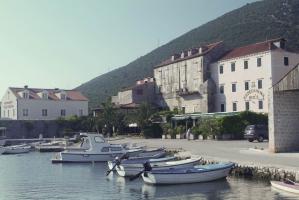 Kapetanova Kuca
Kapetanova Kuca
No sooner had we parked ourselves though than a massive plate of the plumpest, briniest oysters from the bay arrived, to be accompanied by Ernest’s 2009 Nevina Istra, a barrel-fermented malvasia and chardonnay blend which was a little too full and fat for the freshness of the oysters. Better was the 2009 Saints Heels Rosé, resulting from a saignée of plavac mali, and showing good ripe berry fruit, a nicely dry and quite refreshing acidity. Also tasted were a 2008 Saints Hills Dingać Vinograd sv Lucia, a 2007 Bura Dingać, and a 2007 Mare Postup. I didn’t think these big powerful reds were ideal seafood wines, but I learn next day that it's traditional in Ston to drink Dingać with oysters because of the complement of minerality. So there you go. Wine notes are at the end by the way, for those who like reading them.
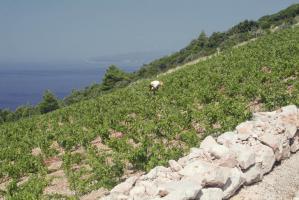 Ernest Tolj's vineyard at Dingać
Ernest Tolj's vineyard at Dingać
Joined by the bubbly Croatian winemaker Josipa Andrijanic (not the Croatian bubbly winemaker) for the day, we headed off on a cloudless warm and sunny morning, to visit Dingać with Ernest Tolj. With perhaps 75 – 80 hectares of plavac mali planted, and 100 –odd small growers, Dingać is one of the best spots for plavac mali and you could see why people like Tolj have felt that investment in the hillside vineyards facing the Adriatic is worthwhile. The olive-lined vineyards are on steep slopes of cracked rock and limestone. You can smell the pine and hear the sound of crickets humming as you drive along the high narrow curving ledge over the Adriatic, and there are fences here to keep out the goats, but unfortunately no-one told the goats.
 Ernest Tolj
Ernest Tolj
As mentioned previously, plavac mali is an indigenous Croatian variety from mid and south Dalmatia. Ampelographers, including Carole Meredith from UCLA Davis and professors Edi Maletić and Ivan Pejić in Croatia, found that plavac mali is a cross between two other indigenous Croatian varieties, crljenak kaštelanski with šoltanski dobričić. Plavac adapts well to the Mediterranean climate and poor rocky soils and is mainly grown as a bush vine with typical aromas and flavours of dark fruits such as black cherry, plum and blackberry. When it’s from Dingać, Postup and Ivan Dolac on Hvar, supposedly its best expressions, it doesn’t have the name of the grape variety on the label.
 Josipa and Saša
Josipa and Saša
At 220 metres above sea level, Ernest Tolj planted four hectares of plavac mali and crljenak two and three years ago and is clearing a space for a new four hectare vineyard. He’s built some drystone terraces here, a labour intensive and expensive process today. Everything is done by hand. Yields are low with only 0.5 – 0.6 kilos per vine expected this year. Tolj has bought an old stone house to make a winery instead of having to transport the grapes to near Split for fermentation. He’s spending an increasing amount of his time here, and I expect the results to be interesting.
From here, Saša, Josipa and I drove to the next area with a reputation for plavac mali: Postup in Orebic. Famous for its sea captains, Orebic is a lovely old resort town on the Adriatic with 18th century houses that line the seafront, some with the classic Korta, a garden courtyard in front of the house. Although it has long, sandy and rocky beaches, it’s not too touristy. We visited Korta Katarina, a winery and a hotel, dating from 1937, being renovated by Lee Anderson, a Minneapolitan. Korta Katarina has 5.5 hectares in Postup and Dingać and 0.3 hectares of zinfandel. The first year of production was 2006 and the wines, made by Nika Silic, a winemaker from Korćula , are promising.
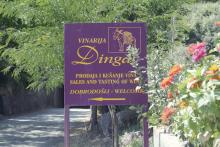 Dingać
Dingać
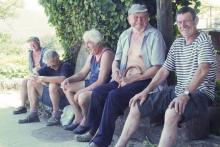 Men of Dingać
Men of Dingać
The 2008 Korta Katarina Pošip , Polozaja Cara, is from Korćula too, and shows the potential of Pošip, a white native of Korćula (whose parents, you’ll want to know, are Zlatarica Blatska and Bratkovina) that’s rapidly becoming one of Dalmatia’s most popular. Perhaps Nika would say that as a Korćulanka, but she genuinely thinks the best examples come from the island of Korćula. Nika also told us that in the past, it was only used for sweet wines because of its acidity and that its aromas vary according to ripeness levels and vinification methods. We went on to taste some plavac mali. Nika said it’s impossible to make plavac mali without ageing in oak since its strong tannins need time in oxidative conditions, and micro-oxygenation, to soften down.
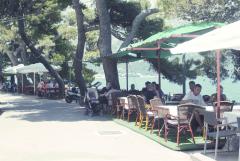 Lešić Dmitri restaurant on Korćula
Lešić Dmitri restaurant on Korćula
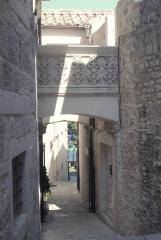 Lešić Dmitri hotel on Korćula
Lešić Dmitri hotel on Korćula
At lunchtime, we take a speedboat from Orebic to the enchanting island of Korćula and Lešić Dmitri. Lešić Dmitri is a beautifully renovated boutique hotel with a restaurant along a pine-lined balcony terrace overlooking the shimmering greeny-blue Adriatic facing the mainland. Across from the wall on the island side are stone houses and hotels in dappled sunlight, adorned with bougainvillea. Below the sea wall, you can see people messing about in boats, swimming, fishing and yachting just a short distance from this island paradise. With robust, firm shark medallions with sage and prosciutto, we taste some dry whites from the island, a 2008 Grgic Pošip, Korćula and a 2009 Grk Pillos. Yes, a Grk, a local variety which has small and large berries and a tendency to bitterness (the name could come from gorak = bitterness, or from Greece) and grows best in the red sandy soils of Lumbarda.
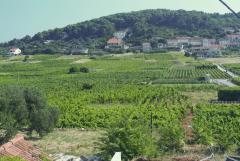 sea of Grk
sea of Grk
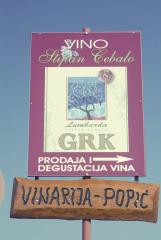 at the sign of Grk
at the sign of Grk
Luka Krajančić meets us and before we head off to his house on the beach for supper, we take a look at the island’s vineyards of Grk at Lumbarda, which is surrounded by sea on three sides. Then it’s off to the beach for an appetite-whetting dip and we need our appetites whetted big time as it looks like he’s preparing a feast for us. We’re taking some fresh lobsters with us and we’ve heard about his reputation as a cook. We start with a very fresh 2009 Pošip, lightly smoky and lemony with a dish of marinated whelks, anchovies, shrimps and lobster, the lobster just in case he didn’t manage to find any fresh. We move on to a dish of clams just boiled with a little butter and herb, which are sweet, fresh and mildly but not excessively chewy. Then comes a sea urchin pasta, an incredibly rich and strong dish, containing 150 fresh sea urchins. Like shellfish in general only more so, it really does contain that concentrated briney taste of the sea.
 Luka Krajančić
Luka Krajančić
On to octopus simmered in pošip with a rich olive oil-based sauce and then monkfish stew to follow. We try the 2008 Intrada Pošip sur lie, which is smoky, fresh and buttery, white Burgundy style almost, and a richer, more substantial accompaniment to the octopus and monkfish. It’s famous for having been served to Pope John Paul II and his entourage in the restaurant Nautica during his visit to Dubrovnik in June 2003. A break is called for before the lobster, which is barbecued to perfection. The Pošip sur lie is just right with it. As if this isn’t enough, Luka re-appears with an absurdly light carob meringue cream pudding and a sweet Pošip to accompany it. Time for Luka’s Croatian poems, poems about the smell of coffee and his childhood, recited clearly and loudly, and greeted with cries of appreciation and applause. A speedboat taxi awaits us for a moonlit ride back to the mainland.
The Wines
2009 Nevina Istra. 70% malvasia and chardonnay, a smooth and concentrated white with rich barrel-fermented texture and ripe, full-bodied, opulent flavours, quite fat, needing a zip of fresh acidity. 87
2009 Saints Heels Rosé. Bleeding of plavac mali, full, berry fruit, nicely dry and quite refreshing, good texture and balance, very good food rosé. 88
2008 Saints Hills Dingać Vinograd sv Lucia. Fragrant mulberry and loganberry sweet fruit on the nose almost like a very ripe grenache, with smoky vanillin oak; rich, sweet, full and smoky black cherry and dried fig, oaky, powerful and extracted; but nice cooled on a warm evening al fresco. 89
2007 Bura Dingać. Rich, sweet and porty with sweet vanilla, dried fig and black cherry jam nose with firm tannins and good acidity, sort of dark plum, primitivo-like, drier finish; big, sweet and powerful with substantial oak and tannins, bit of a brute; needs a hard cheese. 88
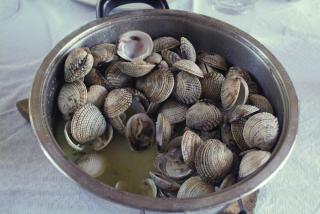 Krajančić clams
Krajančić clams
2007 Mare Postup. Vinogorje Peljesac. Dense, smells like sweet mulberry and blackberry jam; sweet dried dark red fruits richness but nice supple texture and freshness despite the power. 90
2008 Korta Katarina Pošip , Polozaja Cara. Fermented in stainless steel and part matured in used oak barrels, this has attractively fresh olive and lemon aromas, a richly textured fruit quality, a minerally edge and refreshing lemony acidity. 90
2006 Korta Katarina Pošip , Polozaja Cara, Korćula. Showing evident oak on the nose, but still with good rich, nicely textured fruit, a citrusy, herby note, and while a softer, riper and more buttery and nutty, holding up with nice freshness to it. 90
2007 Korta Katarina Pošip , Polozaja Cara, Korćula. Showing an intriguing olivey nose, with notes of herb and lemon, displaying more powerful fruit richness, with buttery and nutty tones, nicely integrated oak and a touch of honey on the finish. 89
2009 Korta Katarina Rosé. A blend of plavac and zinfandel, part matured in wood, fragrantly strawberryish, full, ripe and smoothly textured with an elegant dryness to it and very much a food wine. 88
2006 Korta Katarina Plavac Mali, Peljesac Peninsula. Deepish ruby garnet with a sweet nose of plum, black olive and pepper, and herby notes like fennel and celery, good sweet dark damson fruits and tapenadey touches, nicely supple-textured with slight green bitter note on back palate; from oak? 87
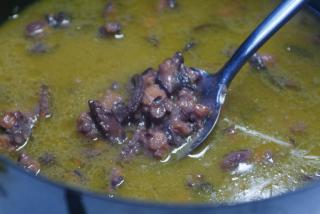 Krajančić octopus
Krajančić octopus
2006 Korta Katarina Plavac Mali, Peljesac Peninsula. Same wine aged another year in oak, tapenadey and liquoricey aromas, herby, celery, richer and more concentrated black fruits flavours, intense, bittersweet chocolate and damson, still with firm grip and backbone. 89
2009 Pošip Smokvica Korćula. Pale, lemony, smoky and dry, good refreshing spritz to it and nicely dry and crisp. 87
2008 Pošip Smokvica Korćula. Bit more depth, nice and spicy, and dry. 88
2008 Grgic Pošip, Korćula (yes Grgic of Grgic Hills, California, fame) shows good fresh lemony fruit with smoky whisper oaf oak, good freshness and body. 88
2009 Grk Pillos is lightly smoky, light, fresh, lemony and dry with an Italian dry white feel to it. It tastes good in the sun overlooking the Adriatic and maybe it’s the best place for it. 86
2009 Pošip Intrada Krajančić. This is lightly smoky, refreshingly zesty with herbal undertones and lemony and goes beautifully with just about every kind of shellfish. 89
2008 Pošip sur lie, Krajančić. This is smoky, fresh and buttery, white Burgundy style almost, and a richer, more substantial accompaniment to the octopus and monkfish, with an almost honeyed finish. 89
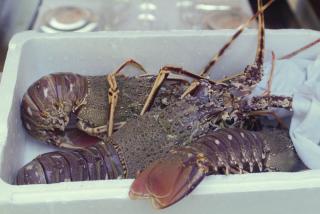 Krajančić lobster
Krajančić lobster

